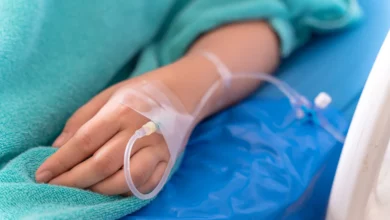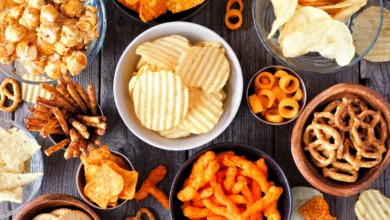
Cutting 1 teaspoon of salt from your diet each day can lower your top blood pressure reading just as much as a typical hypertension medication, even if you don’t have high blood pressure, a new study found.
A teaspoon of salt is 2,300 milligrams — that’s the top daily limit for people over 14 recommended by the latest US nutritional guidelines. However, the American Heart Association recommends a diet with less than 1,500 milligrams of sodium a day.
“This is the first study to show that people who are already on blood pressure medication can lower their blood pressure even more by limiting sodium,” said coprincipal investigator Norrina Allen, professor of preventive medicine at Northwestern University’s Feinberg School of Medicine.
“And regardless of medication, we found 70 percent to 75 percent of people are likely to see a reduction in their blood pressure if they lower the sodium in their diet,” Allen said.
High blood pressure is often called the “silent killer,” because there are no symptoms — the only way to know if you have it is to test for it. Yet hypertension affects 1 in 3 adults worldwide and can lead to heart attack, heart failure, kidney damage and stroke, according to a 2023 report by the World Health Organization.
Nearly half of all Americans live with high blood pressure, according to the American Heart Association. About a third of those have “resistant” hypertension, high blood pressure that has not responded despite the concurrent use of three types of medications. A 2021 study found men ages 20 to 49 are up to 70 percent more likely to have uncontrolled hypertension than women of the same age.
“Most people today eat way too much salt because it’s added into nearly everything we eat,” said Dr. Andrew Freeman, director of cardiovascular prevention and wellness at National Jewish Health in Denver.
“A teaspoon of salt may seem like a small amount. However, that added salt seems to have an effect on blood pressure that is surprisingly large,” said Freeman, who was not involved in the study.
Middle-aged and older adults
The study, published Saturday in the journal JAMA, assigned 213 people ages 50 to 75 to one week of a high- or low-sodium diet. After eating that diet for seven days, each person then switched to the alternate diet.
About 25 percent of the participants had normal blood pressure, while another 25 percent had untreated hypertension. Of the remaining group, 20 percent had blood pressure under control, while 31 percent did not.
During the high-salt week, people ate their normal diet, along with two bouillon packets, each containing 1,100 milligrams of sodium. During the low-salt week, people ate foods with low sodium, purchased and given to them by dietitians. The goal was only 500 milligrams of salt a day, a dramatic drop.
The drop in blood pressure while on the low-sodium diet was quick and dramatic, according to the study. Compared to the high-sodium diet, blood pressure on the extremely low-salt diet dropped 8 millimeters of mercury.
“Compared to their normal diet, people reduced their blood pressure by about 6 millimeters of mercury, about the same effect you’d see for a first-line blood pressure medication,” Allen said.
“In addition, that drop happened pretty quickly and was consistent for people with normal blood pressure, slightly high blood pressure or those already on medications.”
Cutting this amount of salt didn’t have any significant side effects, Allen said, unless you count adjusting to a blander diet.
“When you go from a high-salt diet to a low-salt diet, everything tastes bland,” she said. “I want to encourage people to stick with it because your taste buds do adjust within a couple of weeks or so, and you really do get taste and flavor back and normal things will taste very salty.
“Taste bud adjustment takes a little bit longer, but the blood pressure improvements are pretty quick,” she added.
Blood pressure medications, however, can have many side effects, including cough, constipation or diarrhea, dizziness, lack of energy, headache, muscle pain, nausea, nervousness, fatigue, weight gain or loss, and erection issues. Typically, these ease over time, according to the National Library of Medicine.
Overcoming cravings for salt
Putting down the saltshaker is a good start, “but that’s not where most people get their salt,” Freeman said.
“It’s in foods you’d not expect to have a lot of salt: A couple of slices of bread could have 400 or 500 milligrams of salt; a pickle has a full day’s worth of salt; and a bowl of soup could have several days’ worth of salt in it,” he said.
But careful shopping can accomplish the task, Allen said. Dietitians purchased the low-sodium diets provided in the study after reading labels at local grocery stores, Allen said.
CNN looked at the low-salt menu and found most breakfasts included store-bought quick oats, Greek yogurt and grapes, while lunch featured grilled chicken, lettuces dressed with oil and vinegar, and low-salt versions of lentil soup, breads, peanut butter and tortilla chips. Dinners included ready-to-eat brown rice and veggies, burritos and lasagna.
“They were the low-salt versions of vegetable lasagna,” Allen said. “They were apples and bananas and things everyone could get at the grocery store. They were not specially prepared by a chef.”
The award-winning DASH diet, which stands for Dietary Approaches to Stop Hypertension, is an expert-approved method of lowering salt intake. DASH has a simple premise: Eat more veggies, fruits and low-fat dairy foods; limit foods high in saturated fat; and limit your sodium intake to 2,300 milligrams a day, just as this study did.
The DASH meal plan includes four to six servings of vegetables and another four to six servings of fruit, three servings of whole-grain products, two to four servings of fat-free or low-fat dairy products, and several servings each of lean meats and nuts, seeds and legumes each day.
Regardless of which diet plan chosen, those who want to cut salt are better off making their own foods at home, where they can read labels and calculate sodium levels, Freeman said.
Eating at a restaurant, even if it’s healthy, could be troublesome.
“Take a vegetable dish at a restaurant: Those green beans may have been prepared with salted butter with salted crispy onions or whatever on top. Before long you’ve had a huge salt load that was never intended,” Freeman said. “The best way to eat is to eat as unprocessed as possible.”




